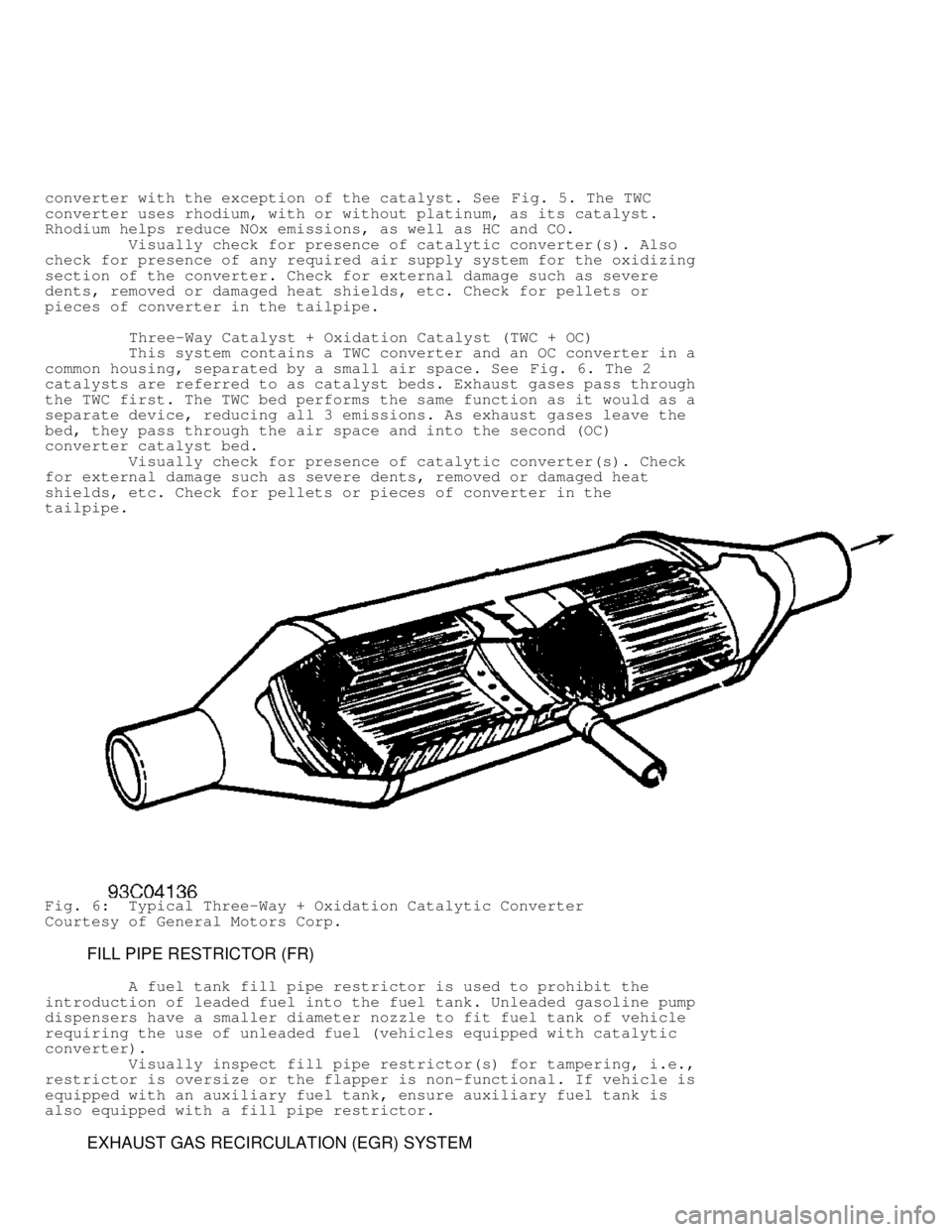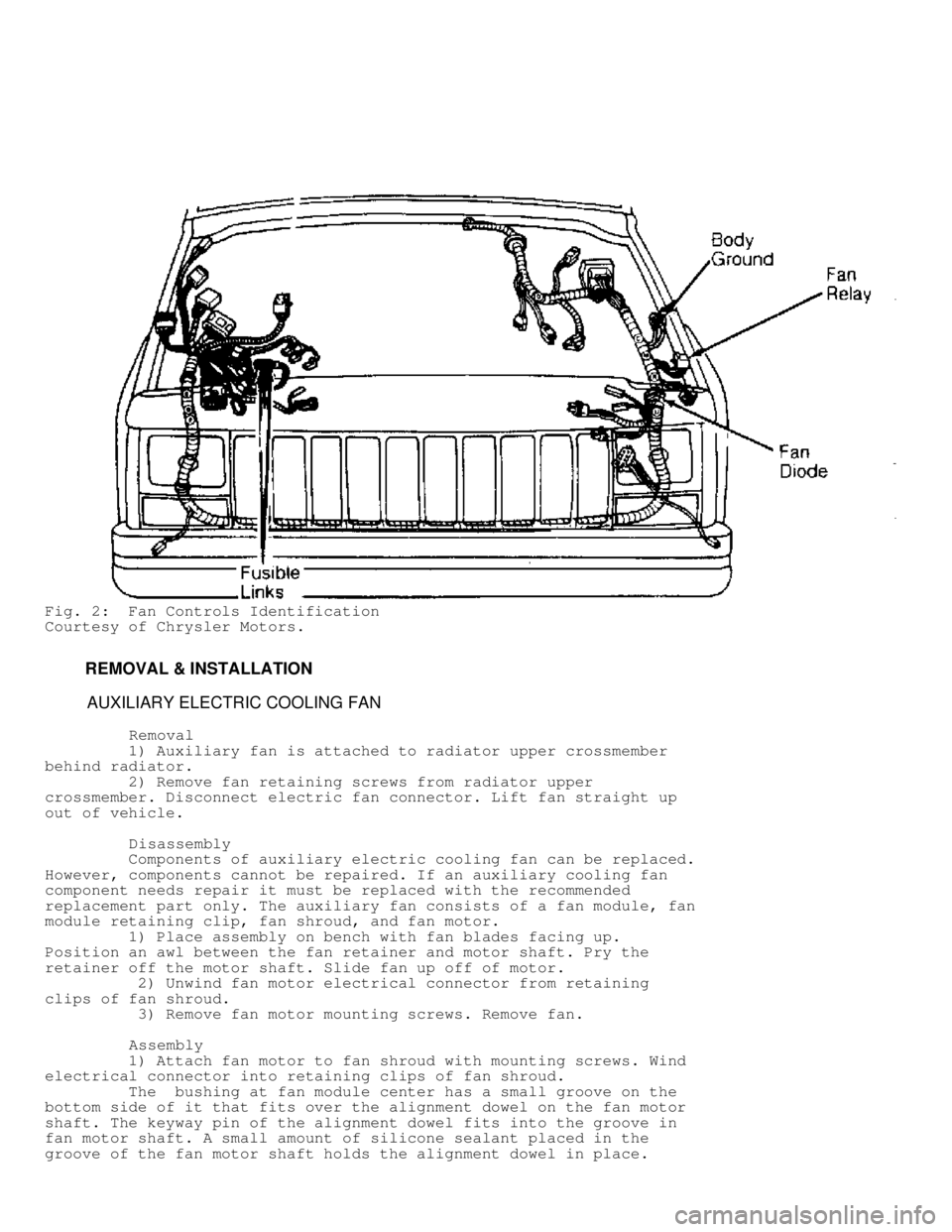Page 577 of 1378

converter with the exception of the catalyst. See Fig. 5. The TWC
converter uses rhodium, with or without platinum, as its catalyst.
Rhodium helps reduce NOx emissions, as well as HC and CO.
Visually check for presence of catalytic converter(s). Also
check for presence of any required air supply system for the oxidizing
section of the converter. Check for external damage such as severe
dents, removed or damaged heat shields, etc. Check for pellets or
pieces of converter in the tailpipe.
Three-Way Catalyst + Oxidation Catalyst (TWC + OC)
This system contains a TWC converter and an OC converter in a
common housing, separated by a small air space. See Fig. 6. The 2
catalysts are referred to as catalyst beds. Exhaust gases pass through
the TWC first. The TWC bed performs the same function as it would as a
separate device, reducing all 3 emissions. As exhaust gases leave the
bed, they pass through the air space and into the second (OC)
converter catalyst bed.
Visually check for presence of catalytic converter(s). Check
for external damage such as severe dents, removed or damaged heat
shields, etc. Check for pellets or pieces of converter in the
tailpipe.
Fig. 6: Typical Three-Way + Oxidation Catalytic Converter
Courtesy of General Motors Corp.
FILL PIPE RESTRICTOR (FR)
A fuel tank fill pipe restrictor is used to prohibit the
introduction of leaded fuel into the fuel tank. Unleaded gasoline pump
dispensers have a smaller diameter nozzle to fit fuel tank of vehicle
requiring the use of unleaded fuel (vehicles equipped with catalytic
converter).
Visually inspect fill pipe restrictor(s) for tampering, i.e.,\
restrictor is oversize or the flapper is non-functional. If vehicle is
equipped with an auxiliary fuel tank, ensure auxiliary fuel tank is
also equipped with a fill pipe restrictor.
EXHAUST GAS RECIRCULATION (EGR) SYSTEM
Page 596 of 1378

EN G IN E C O OLIN G F A N
�
1988 J e ep C hero ke e
1987-88 ENGINE COOLING
Thermostatically Controlled Electric Fans
Cherokee, Comanche, Wagoneer
DESCRIPTION & OPERATION
On Cherokee, Comanche and Wagoneer models with a 4.0L engine,
A/C and/or heavy duty cooling system, an auxiliary electric fan is
used. The auxiliary fan is controlled by a relay mounted on the left
inner fender panel. A radiator temperature switch attached to the
radiator outlet tank above the lower radiator hose senses engine
coolant temperature.
When coolant temperature is more than 190(0)F (88(0)C), t\
he
radiator coolant temperature switch closes allowing current from the
ignition switch to flow through the fan relay to ground activating the
relay. When relay is activated, battery voltage is supplied to the fan
causing it to operate. When coolant temperature is below 190(0)F
(88(0)C), the radiator coolant temperature switch opens preventing t\
he
relay from being grounded and electric cooling fan from being
energized.
When the A/C (if equipped) is turned on, the Electronic
Control Unit (ECU) grounds the A/C relay coil allowing current to flow\
through it. This activates the A/C relay which then supplies current
to the A/C clutch, fan diode assembly and cooling fan relay. The
cooling fan relay is activated and the fan operates. Whenever the A/C
is used, regardless of engine coolant temperature, the auxiliary
electric cooling fan operates.
TESTING
NOTE: For following tests, refer to fan relay connector terminal
identification and fan controls identification. See Figs. 1
and 2.
With Air Conditioning
1) If electric cooling fan does not work all the time, go to
step 3). If electric cooling fan is inoperative when A/C compressor
operates, start engine and turn A/C on. Disconnect fan relay
connector. Fan relay is located on left inner fender panel.
2) Using a voltmeter, check for voltage at fan relay
connector terminal No. 2. If voltmeter does not read battery voltage,
replace fan diode assembly.
3) Disconnect fan relay connector. Fan relay is located on
left inner fender panel. Using a jumper wire with an in-line 25-amp
fuse, supply battery voltage to fan relay connector terminal No. 4.
4) If fan operates, motor is okay. Go to next step. If fan
motor does not operate, check continuity between fan relay connector
terminal No. 4 and body ground connections. If continuity exists,
replace fan motor. If continuity does not exist, repair open and
retest.
5) Disconnect fan relay connector. Turn ignition switch to
the "RUN" position. Check continuity between fan relay connector
terminal No. 5 and body ground connections. If continuity does not
exist, repair open circuit. If continuity exists, go to next step.
6) Using a jumper wire with an in-line 25-amp fuse, jump
across fan relay connector terminals No. 1 and No. 4. If fan motor
operates, go to next step. If fan motor does not operate, repair fan
Page 598 of 1378

Fig. 2: Fan Controls Identification
Courtesy of Chrysler Motors.
REMOVAL & INSTALLATION
AUXILIARY ELECTRIC COOLING FAN
Removal
1) Auxiliary fan is attached to radiator upper crossmember
behind radiator.
2) Remove fan retaining screws from radiator upper
crossmember. Disconnect electric fan connector. Lift fan straight up
out of vehicle.
Disassembly
Components of auxiliary electric cooling fan can be replaced.
However, components cannot be repaired. If an auxiliary cooling fan
component needs repair it must be replaced with the recommended
replacement part only. The auxiliary fan consists of a fan module, fan
module retaining clip, fan shroud, and fan motor.
1) Place assembly on bench with fan blades facing up.
Position an awl between the fan retainer and motor shaft. Pry the
retainer off the motor shaft. Slide fan up off of motor.
2) Unwind fan motor electrical connector from retaining
clips of fan shroud.
3) Remove fan motor mounting screws. Remove fan.
Assembly
1) Attach fan motor to fan shroud with mounting screws. Wind
electrical connector into retaining clips of fan shroud.
The bushing at fan module center has a small groove on the
bottom side of it that fits over the alignment dowel on the fan motor
shaft. The keyway pin of the alignment dowel fits into the groove in
fan motor shaft. A small amount of silicone sealant placed in the
groove of the fan motor shaft holds the alignment dowel in place.
Page 599 of 1378
2) Place fan module over motor shaft, align groove in fan
module with dowel on motor shaft. Start fan module retainer onto the
fan motor shaft with open end of the retainer facing the groove in the
shaft. When retainer is completely installed the open end will be on
side opposite the groove. Use needle nose pliers to finish installing
retainer.
Installation
Align lower retaining tabs of fan shroud with slots in
bracket at bottom of radiator and push fan down into position. Tighten
mounting screws to 36 inch lbs. (4.07 N.m). Connect auxiliary cooling
fan electrical connector.
Fig. 3: Auxiliary Fan Removal & Installation
Page 600 of 1378